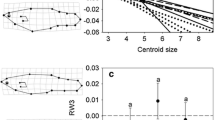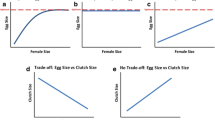Abstract
Allometric relationships of reproductive output were compared in 20 species from 7 families of brachyuran crabs from the east and west coasts of North America, using regression analysis of log reproductive parameters versus log body weight. Comparisons of crabs spanning 4 orders of magnitude in body weight indicated that female body size was the principal determinant of reproductive output: 95% of the variance in brood weight, 79% of the variance in the number of eggs per brood, 63% of the variance in annual brood weight, and 74% of the variance in annual fecundity were explained by body weight. Brood weight exhibited an isometric constraint to about 10% of body weight. Allometric limitations on space available for yolk accumulation in the body cavity appeared to be the main constraint on brood size. Ovum size increased significantly, but only slightly, with increasing body size. There was a significant trade-off between ovum size and the number of eggs per brood. There was no significant relationship between the number of broods per year and body size. The number of eggs per brood was significantly better than brood weight as a predictor of the number of broods produced per year by a species, indicating that demographic pressure on fecundity rather than energetic considerations is the primary selective mechanism influencing annual reproductive effort. Each of the 7 families of crabs exhibited trends toward distinct patterns for the suite of co-adapted reproductive traits. However, no interspecific reproductive patterns were apparent with respect to the variables of feeding type, salinity tolerance, habitat, and geographic range represented by the 20 species.
Similar content being viewed by others
Literature Cited
Barnes, H. and M. Barnes: Egg size, nauplius size, and their variation with local, geographical, and specific factors in some common cirripedes. J. Anim. Ecol. 34, 390–402 (1965)
Barnes, H. and M. Barnes: Egg numbers, metabolic efficiency of egg production and fecundity: local and regional variations in a number of common cirripedes. J. exp. mar. Biol. Ecol. 2, 135–153 (1968)
Belk, D.: Evolution of egg size strategies in fairy shrimps. SWest. Nat. 22, 99–105 (1977)
Bertness, M. D.: Pattern and plasticity in tropical hermit crab growth and reproduction. Am. Nat. 117, 754–773 (1981)
Boolootian, R. A., A. C. Giese, A. Farmanfarmaian and J. Tucker: Reproductive cycles of five West Coast crabs. Physiol. Zoöl. 32, 213–220 (1959)
Butler, T. H.: Growth and age determination of the Pacific edible crab Cancer magister Dana. J. Fish. Res. Bd. Can. 18, 873–889 (1961)
Corey, S.: Comparative fecundity and reproductive strategies in seventeen species of the Cumacea (Crustacea: Peracarida). Mar. Biol. 62, 65–72 (1981)
Diaz, H.: The mole crab Emerita talpoida (Say): a case of changing life history pattern. Ecol. Monogr. 50, 437–456 (1980)
Efford, I. E.: Egg size in the sand crab, Emerita (Anomura, Hippidae). Crustaceana 16, 15–26 (1969)
Garth, J. S. and D. P. Abbott: Brachyura: the true crabs. In: Intertidal invertebrates of California, pp 594–630. Ed. by R. H. Morris, D. P. Abbott and E. C. Haderlie. Stanford: Stanford University Press 1980
Giesel, J.: Reproductive strategies as adaptations to life in temporally heterogeneous environments. A. Rev. Ecol. Syst. 7, 57–79 (1976)
Gould, S. J.: Allometry and size in ontogeny and phylogeny. Biol. Rev. 41, 587–640 (1966)
Gould, S. J.: Geometric similarity in allometric growth: a contribution to the problem of scaling in the evolution of size. Am. Nat. 105, 113–136 (1971)
Gould, S. J.: On the scaling of tooth size in mammals. Am. Zool. 15, 351–362 (1975)
Guenther, B.: Dimensional analysis and theory of biological similarity. Physiol. Rev. 55, 659–699 (1975)
Haefner, P. A., Jr.: Reproductive biology of the female deep-sea red crab, Geryon quinquidens, from the Chesapeake bight. Fish. Bull. U.S. 75, 91–102 (1977)
Haefner, P. A., Jr.: Seasonal aspects of the biology, distribution, and relative abundance of the deep-sea red crab, Geryon quinquidens Smith, in the vicinity of the Norfolk Canyon, western North Atlantic. Proc. natn. Shellfish. Ass. 68, 49–61 (1978)
Hiatt, R. W.: The biology of the lined shore crab, Pachygrapsus crassipes Randall. Pacif. Sci. 2, 135–213 (1948)
Hines, A. H.: Reproduction in three species of intertidal barnacles from central California. Biol. Bull. mar. biol. Lab., Woods Hole 154, 262–281 (1978)
Hines, A. H.: The comparative reproductive ecology of three species of intertidal barnacles. In: Reproductive ecology of marine invertebrates, pp 213–234. Ed. by S. E. Stancyk. Columbia: University of South Carolina Press 1979. (Contr. Belle W. Baruch Libr. mar. Sci. No. 9)
Hines, A. H.: Life history strategies of spider crabs (Majidae). Am. Zool. 21, p. 990 (1981)
Hines, A. H.: Coexistence in a kelp forest: size, population dynamics, and resource partitioning in a guild of spider crabs. Ecol. Monogr. 52, 179–198 (1982)
Hinsch, G. W.: Reproductive behavior in the spider crab Libinia emerginata (L.) Biol. Bull. mar. biol. Lab., Woods Hole 135, 273–278 (1968)
Hubbs, C., M. S. Stevenson and A. E. Peden: Fecundity and egg size in two central darter populations. SWest. Nat. 13, 301–324 (1968)
Kaplan, R. H. and S. N. Salthe: The allometry of reproduction: an empirical view in salamanders. Am. Nat. 113, 671–689 (1979)
Knowlton, R. E.: Larval developmental processes and controlling factors in decaped Crustacea, with emphasis on Caridea. Thalassia jugosl. 10, 139–158 (1974)
Knudsen, J. W.: Reproduction, life history and larval ecology of the California Xanthidae, the pebble crabs. Pacif. Sci. 14, 3–17 (1960)
Kuramoto, M.: Correlations of quantitative parameters of fecundity in amphibians. Evolution, Lawrence, Kansas 32, 287–296 (1978)
Lack, D.: Ecological adaptations for breeding in birds, 409 pp. London: Chapman & Hall 1968
Lasenby, D. C. and R. R. Langford: Growth, life history and respiration of Mysis relicta in an arctic and temperate lake. J. Fish. Res. Bd Can. 29, 1701–1708 (1972)
Lawlor, L. R.: Parental investment and offspring fitness in the terrestrial isopod Armadillidium vulgare (Latr.) (Crustacea: Oniscoidea). Evolution, Lawrence, Kansas 30, 775–785 (1976)
Leutenegger, W.: Allometry of neonatal size in eutherian mammals. Nature, Lond. 263, 229–230 (1976)
Leutenegger, W.: Evolution of litter size in primates. Am. Nat. 114, 525–531 (1979)
Mauchline, J.: The broods of British Mysidacea (Crustacea). J. mar. biol. Ass. U.K. 53, 801–817 (1973)
McDonald, J., The comparative intertidal ecology and niche relations of the sympatric mud crabs Panopeus herbstii Milne-Edwards and Eurypanopeus depressus (Smith) at North Inlet, S. Carolina, USA (Decapoda: Brachyura: Xanthidae), 208 pp. Ph.D. dissertation, University of South Carolina 1977
McLaren, I. A.: Predicting development rate of copepod eggs. Biol. Bull. mar. biol. Lab., Woods Hole 131, 457–469 (1966)
McLaren, I. A., C. J. Corkett and E. J. Zillioux: Temperature adaptations of copepod eggs from the arctic to the tropics. Biol. Bull. mar. biol. Lab., Woods Hole 137, 486–493 (1969)
Mileikovsky, S. A.: Types of larval development in marine bottom invertebrates, their distribution and ecological significance: a re-evaluation. Mar. Biol. 10, 193–213 (1971)
Morizur, Y., G. Conan, A. Guénolé et M. H. Omnès: Fécondité de Nephrops norvegicus dans le golf de Gascogne. Mar. Biol. 63, 319–324 (1981)
Nelson, W. G.: Reproductive patterns of gammaridean amphipods. Sarsia 65, 61–71 (1980)
Palmer, M. A.: Variation in life-history patterns between intertidal and subtidal populations of the meiobenthic copepod Microarthridion littorale. Mar. Biol. 60, 159–165 (1980)
Patel, B. and D. J. Crisp: Rates of development of the embryos of several species of barnacles. Physiol. Zoöl. 33, 104–119 (1960)
Perron, F. E. and R. H. Carrier: Egg size distributions among closely related marine invertebrate species: are they bimodal or unimodal? Am. Nat. 118, 749–755 (1981)
Powers, C. W.: A catalogue and bibliography to the crabs (Brachyura) of the Gulf of Mexico. Contr. mar. Sci. Univ. Tex. 20 (Suppl.), 1–190 (1977)
Rabalais, N. N. and J. N. Cameron: Larval development of Uca subcylindrica. Am. Zool. 21, p. 990 (1981)
Rahn, H., C. V. Paganelli and A. Ar: Relation of avian egg weight to body weight. Auk 92, 750–765 (1975)
Reaka, M. L.: The evolutionary ecology of life history patterns in stomatopod Crustacea. In: Reproductive ecology of marine invertebrates, pp 235–260. Ed. by W. E. Stancyk. Columbia: University of South Carolina Press 1979. (Contr. Belle W. Baruch Libr. mar. Sci. No. 9)
Reaka, M. L.: Geographic range, life history patterns, and body size in a guild of coral-dwelling mantis shrimps. Evolution, Lawrence, Kansas 34, 1019–1030 (1980)
Rice, A. L.: Crab zoeal morphology and its bearing on the classification of the Brachyura. Trans. zool. Soc. Lond. 35, 271–424 (1980)
Robbins, C. T. and B. L. Robbins: Fetal and neonatal growth patterns and maternal reproductive effort in ungulates and subungulates. Am. Nat. 114, 101–116 (1979)
Sandifer, P. A.: Distribution and abundance of decapod crustacean larvae in the York River estuary and adjacent lower Chesapeake Bay, Virginia, 1968–1969. Chesapeake Sci. 14, 235–257 (1973)
Seiple, W.: Distribution, habitat preferences and breeding periods in the crustaceans Sesarma cinereum and S. reticulatum (Brachyura: Decapoda: Grapsidae). Mar. Biol. 52, 77–86 (1979)
Stearns, S. C.: Life history tactics: a review of the ideas. Q. Rev. Biol. 51, 3–47 (1976)
Stearns, S. C.: The evolution of life history traits: a critique of the theory and a review of the data. A. Rev. Ecol. Syst. 8, 145–171 (1977)
Stearns, S. C.: A new view of life history evolution. Oikos 35, 266–281 (1980)
Steele, D. H.: Correlations between egg size and developmental period. Am. Nat. 111, 371–372 (1977)
Steele, D. H. and V. J. Steele: The biology of Gammarus (Crustacea, Amphipoda) in the northwestern Atlantic. VII. The duration of embryonic development in five species at various temperatures. Can. J. Zool. 51, 995–999 (1973)
Steele, D. H. and V. J. Steele: Egg size and duration of embryonic development in Crustacea. Int. Revue ges. Hydrobiol. 60, 711–715 (1975a)
Steele, D. H. and V. J. Steele: The biology of Gammarus (Crustacea, Amphipoda) in the Northwestern Atlantic. XI. Comparison and discussion. Can. J. Zool. 53, 1116–1126 (1975b)
Strathmann, R. R.: Egg size, larval development, and juvenile size in benthic marine invertebrates. Am. Nat. 111, 373–376 (1977)
Sweet, S. S.: Allometric inference in morphology. Am. Zool. 20, 643–652 (1980)
Thorson, G.: Reproductive and larval ecology of marine bottom invertebrates. Biol. Rev. 25, 1–45 (1950)
Thurman, C. L. and J. R. Thurman: Development and population structure of Uca subcylindrica. Am. Zool. 21, p. 990 (1981)
Underwood, A. J.: On models for reproductive strategy in marine benthic invertebrates. Am. Nat. 108, 874–878 (1974)
Vance, R. R.: On reproductive strategies in marine benthic invertebrates. Am. Nat. 107, 339–352 (1973)
Van Dolah, R. F. and E. Bird: A comparison of reproductive patterns in epifaunal and infaunal gammaridean amphipods. Estuar. cstl mar. Sci. 11, 593–604 (1980)
Wear, R. G.: Incubation in British decapod Crustacea, and the effects of temperature on the rate and success of embryonic development. J. mar. biol. Ass. U.K. 54, 745–762 (1974)
Williams, A. B.: Marine decapod crustaceans of the Carolinas. Fishery Bull. Fish Wildl. Serv. U.S. 65, 1–298 (1965)
Author information
Authors and Affiliations
Additional information
Communicated by J. Mauchline, Oban
Rights and permissions
About this article
Cite this article
Hines, A.H. Allometric constraints and variables of reproductive effort in brachyuran crabs. Mar. Biol. 69, 309–320 (1982). https://doi.org/10.1007/BF00397496
Accepted:
Issue Date:
DOI: https://doi.org/10.1007/BF00397496




